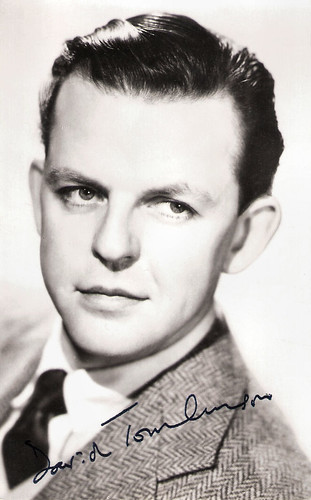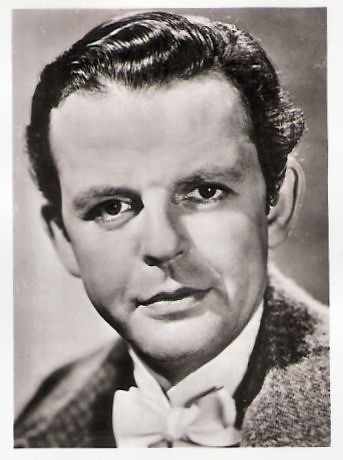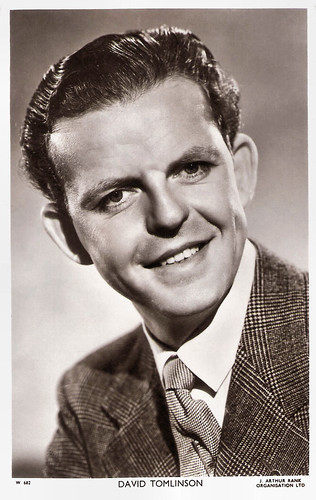British actor David Tomlinson (1917-2000) was both a leading man, a character actor and a comedian. He is best remembered for his roles in the Walt Disney successes Mary Poppins (1964) as authority figure George Banks, The Love Bug (1968) as hapless antagonist Peter Thorndyke, and Bedknobs and Broomsticks (1971) as fraudulent magician Professor Emelius Browne.

British autograph card.

Dutch autograph card. Photo": Eagle Lion.
David Cecil MacAlister Tomlinson was born in Henley-on-Thames, Oxfordshire in 1917, to Florence Elizabeth Tomlinson (née Sinclair-Thomsona) and Clarence Samuel Tomlinson. His well-respected London solicitor father had an uncertain temper, who once burned his baby son's hand with a domestic iron and who, for years, ran a second, secret household in London from Mondays to Fridays, returning to his wife and children in Folkstone at weekends.
David attended Tonbridge School and left to join the Grenadier Guards for 16 months. His father then secured him a job as a clerk at Shell Mex House.
His stage career grew from amateur stage productions to his film debut in Quiet Wedding (Anthony Asquith, 1941), as Margaret Lockwood's brother John, hopelessly in love with Peggy Ashcroft.
It was followed by roles in the comedy My Wife's Family (Walter C. Mycroft, 1941), and the British anti-Nazi thriller "Pimpernel" Smith (1941), produced and directed by its star Leslie Howard, which updates his role in the 1934 The Scarlet Pimpernel from Revolutionary France to pre-Second World War Europe. It was the third most popular film at the British box office in 1941.
Tomlinson’s career was interrupted when he entered Second World War service as a Flight Lieutenant in the RAF. During the war, he served as a flight instructor in Canada and made three films. His flying days continued after the war and later, in 1957, he crashed a Tiger Moth plane near his back garden after he lost consciousness while flying.
Tomlinson was first married to Mary Lindsay Hiddingh, daughter of L. Seton Lindsay, the vice president of the New York Life Insurance Company. She had been widowed in 1941 when her husband, Major A.G. Hiddingh, was killed in action, leaving her to care for their two young sons. Tomlinson married Mary in September 1943. On 2 December 1943, Hiddingh killed herself and her two sons in a murder-suicide by jumping from a hotel in New York City. She was 34 and her sons Michael 8 and John 6. She had been suffering from depression by the loss of her first husband. She was hoping to join David in England, but while in New York City soon learned she couldn't bring the kids which led to her murder-suicide.
Tomlinson's second wife was actress Audrey Freeman, whom he married in 1953, and the couple remained together for 47 years until his death. They had four sons: David Jr. (born 1954), William (1959), Henry (1963) and James (1956 ?).

Small German Collectors card by Greiling in the Filmstars der Welt Series, 2. Band, Serie E, no. 107. Photo: Rank.

British postcard in the Picturegoer Series, London, no. W 682. Photo: J. Arthur Rank Organisation.
After the war, David Tomlinson played supporting parts in British films like the war drama The Way to the Stars (Anthony Asquith, 1945), starring Michael Redgrave and John Mills, School for Secrets (Peter Ustinov, 1946) starring Ralph Richardson, and the drama Fame is the Spur (Roy Boulting, 1947) with Michael Redgrave and Rosamund John.
A hit was the comedy Miranda (Ken Annakin, 1948) about a beautiful and playful mermaid played by Glynis Johns. Another success was the war film The Wooden Horse (Jack Lee, 1950) in which he co-starred with Leo Genn and Anthony Steel.
Other popular films in which he co-starred were the comedy Three Men in a Boat (Ken Annakin, 1956) with Laurence Harvey, and Shirley Eaton, the comedy Up the Creek (Val Guest, 1958) with Peter Sellers and Wilfrid Hyde-White, and the adventure-comedy Tom Jones (Tony Richardson, 1963) starring Albert Finney.
Hal Erickson at AllMovie: “Tomlinson liked nothing better than to undercut his dignified demeanor in flustered comedy roles, invariably sputtering such expletives as 'My word!', 'I say!', and 'What the deuce!'"
Tomlinson did this exceptionally well in his role as George Banks, head of the Banks family, in Mary Poppins (Robert Stevenson, 1964), alongside the umbrella-borne Julie Andrews and the chimney-sweeping Dick Van Dyke. The Disney film was released to universal acclaim, receiving a total of thirteen Academy Award nominations, including Best Picture – an unsurpassed record for any other film released by Walt Disney Studios – and won five.
Mary Poppins brought Tomlinson continued work with Disney, asking him to appear in The Love Bug (Robert Stevenson, 1968) and Bedknobs and Broomsticks (Robert Stevenson, 1971), with Angela Lansbury.
Throughout the rest of Tomlinson's film career, he never steered far from comedies. On stage he had long-running successes in many plays including The Little Hut with Robert Morley and Roger Moore as his understudy. His final acting appearance was in The Fiendish Plot of Dr. Fu Manchu (Piers Haggard, Peter Sellers, Richard Quine, 1980), which was also the final film of Peter Sellers, who died shortly prior to its release.
Tomlinson retired from acting at age 63 to spend more time with his family. During the last few years of his life, he became notorious around his home village of Mursley for flying very low in his Tiger Moth. In 2000, David Tomlinson died peacefully in his sleep at King Edward VII's Hospital, Westminster, after suffering from a sudden stroke. He was 83 years old. He was interred at his estate grounds in Mursley, Buckinghamshire. In 2002, two years after his death, Tomlinson was posthumously inducted as a Disney Legend.
Trailer Mary Poppins (1964). Source: Film Trailers Channel (YouTube).
Sources: Hal Erickson (AllMovie), Dennis Barker (The Guardian), Luke Cumiskey (IMDb), Wikipedia, and IMDb.

British autograph card.

Dutch autograph card. Photo": Eagle Lion.
Murder-suicide
David Cecil MacAlister Tomlinson was born in Henley-on-Thames, Oxfordshire in 1917, to Florence Elizabeth Tomlinson (née Sinclair-Thomsona) and Clarence Samuel Tomlinson. His well-respected London solicitor father had an uncertain temper, who once burned his baby son's hand with a domestic iron and who, for years, ran a second, secret household in London from Mondays to Fridays, returning to his wife and children in Folkstone at weekends.
David attended Tonbridge School and left to join the Grenadier Guards for 16 months. His father then secured him a job as a clerk at Shell Mex House.
His stage career grew from amateur stage productions to his film debut in Quiet Wedding (Anthony Asquith, 1941), as Margaret Lockwood's brother John, hopelessly in love with Peggy Ashcroft.
It was followed by roles in the comedy My Wife's Family (Walter C. Mycroft, 1941), and the British anti-Nazi thriller "Pimpernel" Smith (1941), produced and directed by its star Leslie Howard, which updates his role in the 1934 The Scarlet Pimpernel from Revolutionary France to pre-Second World War Europe. It was the third most popular film at the British box office in 1941.
Tomlinson’s career was interrupted when he entered Second World War service as a Flight Lieutenant in the RAF. During the war, he served as a flight instructor in Canada and made three films. His flying days continued after the war and later, in 1957, he crashed a Tiger Moth plane near his back garden after he lost consciousness while flying.
Tomlinson was first married to Mary Lindsay Hiddingh, daughter of L. Seton Lindsay, the vice president of the New York Life Insurance Company. She had been widowed in 1941 when her husband, Major A.G. Hiddingh, was killed in action, leaving her to care for their two young sons. Tomlinson married Mary in September 1943. On 2 December 1943, Hiddingh killed herself and her two sons in a murder-suicide by jumping from a hotel in New York City. She was 34 and her sons Michael 8 and John 6. She had been suffering from depression by the loss of her first husband. She was hoping to join David in England, but while in New York City soon learned she couldn't bring the kids which led to her murder-suicide.
Tomlinson's second wife was actress Audrey Freeman, whom he married in 1953, and the couple remained together for 47 years until his death. They had four sons: David Jr. (born 1954), William (1959), Henry (1963) and James (1956 ?).

Small German Collectors card by Greiling in the Filmstars der Welt Series, 2. Band, Serie E, no. 107. Photo: Rank.

British postcard in the Picturegoer Series, London, no. W 682. Photo: J. Arthur Rank Organisation.
Disney Legend
After the war, David Tomlinson played supporting parts in British films like the war drama The Way to the Stars (Anthony Asquith, 1945), starring Michael Redgrave and John Mills, School for Secrets (Peter Ustinov, 1946) starring Ralph Richardson, and the drama Fame is the Spur (Roy Boulting, 1947) with Michael Redgrave and Rosamund John.
A hit was the comedy Miranda (Ken Annakin, 1948) about a beautiful and playful mermaid played by Glynis Johns. Another success was the war film The Wooden Horse (Jack Lee, 1950) in which he co-starred with Leo Genn and Anthony Steel.
Other popular films in which he co-starred were the comedy Three Men in a Boat (Ken Annakin, 1956) with Laurence Harvey, and Shirley Eaton, the comedy Up the Creek (Val Guest, 1958) with Peter Sellers and Wilfrid Hyde-White, and the adventure-comedy Tom Jones (Tony Richardson, 1963) starring Albert Finney.
Hal Erickson at AllMovie: “Tomlinson liked nothing better than to undercut his dignified demeanor in flustered comedy roles, invariably sputtering such expletives as 'My word!', 'I say!', and 'What the deuce!'"
Tomlinson did this exceptionally well in his role as George Banks, head of the Banks family, in Mary Poppins (Robert Stevenson, 1964), alongside the umbrella-borne Julie Andrews and the chimney-sweeping Dick Van Dyke. The Disney film was released to universal acclaim, receiving a total of thirteen Academy Award nominations, including Best Picture – an unsurpassed record for any other film released by Walt Disney Studios – and won five.
Mary Poppins brought Tomlinson continued work with Disney, asking him to appear in The Love Bug (Robert Stevenson, 1968) and Bedknobs and Broomsticks (Robert Stevenson, 1971), with Angela Lansbury.
Throughout the rest of Tomlinson's film career, he never steered far from comedies. On stage he had long-running successes in many plays including The Little Hut with Robert Morley and Roger Moore as his understudy. His final acting appearance was in The Fiendish Plot of Dr. Fu Manchu (Piers Haggard, Peter Sellers, Richard Quine, 1980), which was also the final film of Peter Sellers, who died shortly prior to its release.
Tomlinson retired from acting at age 63 to spend more time with his family. During the last few years of his life, he became notorious around his home village of Mursley for flying very low in his Tiger Moth. In 2000, David Tomlinson died peacefully in his sleep at King Edward VII's Hospital, Westminster, after suffering from a sudden stroke. He was 83 years old. He was interred at his estate grounds in Mursley, Buckinghamshire. In 2002, two years after his death, Tomlinson was posthumously inducted as a Disney Legend.
Trailer Mary Poppins (1964). Source: Film Trailers Channel (YouTube).
Sources: Hal Erickson (AllMovie), Dennis Barker (The Guardian), Luke Cumiskey (IMDb), Wikipedia, and IMDb.
No comments:
Post a Comment